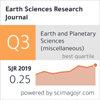Influence of Compaction on Electrical Resistivity Characteristics of Fine-grained Soil East of Baghdad City, Iraq
IF 0.5
4区 地球科学
Q4 GEOSCIENCES, MULTIDISCIPLINARY
引用次数: 0
Abstract
In geotechnical practice, there is a continuous demand for an efficient method for measuring the soil moisture content and dry unit weight of compacted soils used in a wide range of earthwork constructions. The Electrical Resistivity method has increasingly been used for rapid and non-invasive assessment of some geotechnical properties. This study aims to evaluate the influence of Moisture Content (MC), Dry Unit Weight (DUW), and Compaction Energy (E) on the Electrical Resistivity (ER) of soil collected from the east of Baghdad City, Iraq. To achieve this goal, soil specimens were compacted to various MC and DUW found in geotechnical practice using different E levels. The ER of prepared specimens was measured using the two electrodes method and compared with various geotechnical parameters related to the compaction process. The results showed that the employed MC, DUW, and E levels influenced the ER. The higher the MC, DUW, and E, the lower the ER. However, the ER was more sensitive to these variables for specimens compacted dry of the optimum. Furthermore, the ER was correlated very well with Volumetric Moisture Content ϴ and Degree of Saturation Sr of soil, with a high correlation coefficient (R2 >94%) and very low p-values, which indicated that these correlations were statistically significant. The current findings indicate the usefulness of the ER method for predicting these parameters. Therefore, using the ER method as a rapid and cost-effective technique for the preliminary evaluation of soil compaction variables in earthwork constructions is recommended. However, the current laboratory findings must be confirmed on different soil types.压实对伊拉克巴格达市东部细粒土电阻率特性的影响
在岩土工程实践中,一直需要一种有效的方法来测量各种土方工程中使用的土壤含水量和压实土的干单位重。电阻率法已越来越多地用于快速、无创地评价岩土工程性质。本研究旨在评价含水量(MC)、干重(DUW)和压实能(E)对伊拉克巴格达市东部土壤电阻率(ER)的影响。为了实现这一目标,土壤样品被压实成不同的MC和DUW,在岩土工程实践中使用不同的E水平。采用双电极法测量了制备试样的内能,并与与压实过程相关的各种岩土参数进行了比较。结果表明,所使用的MC、DUW和E水平影响ER。MC、DUW和E越高,ER越低。然而,对于压实干燥的最佳试样,ER对这些变量更为敏感。土壤内能与土壤体积含水率ϴ和饱和程度Sr的相关性非常好,相关系数很高(R2 >94%), p值很低,说明这些相关性具有统计学意义。目前的研究结果表明,ER方法对预测这些参数是有用的。因此,推荐使用ER法作为一种快速、经济的方法来初步评估土方工程中土壤压实变量。然而,目前的实验室研究结果必须在不同的土壤类型上得到证实。
本文章由计算机程序翻译,如有差异,请以英文原文为准。
求助全文
约1分钟内获得全文
求助全文
来源期刊

Earth Sciences Research Journal
地学-地球科学综合
CiteScore
1.50
自引率
0.00%
发文量
0
审稿时长
>12 weeks
期刊介绍:
ESRJ publishes the results from technical and scientific research on various disciplines of Earth Sciences and its interactions with several engineering applications.
Works will only be considered if not previously published anywhere else. Manuscripts must contain information derived from scientific research projects or technical developments. The ideas expressed by publishing in ESRJ are the sole responsibility of the authors.
We gladly consider manuscripts in the following subject areas:
-Geophysics: Seismology, Seismic Prospecting, Gravimetric, Magnetic and Electrical methods.
-Geology: Volcanology, Tectonics, Neotectonics, Geomorphology, Geochemistry, Geothermal Energy, ---Glaciology, Ore Geology, Environmental Geology, Geological Hazards.
-Geodesy: Geodynamics, GPS measurements applied to geological and geophysical problems.
-Basic Sciences and Computer Science applied to Geology and Geophysics.
-Meteorology and Atmospheric Sciences.
-Oceanography.
-Planetary Sciences.
-Engineering: Earthquake Engineering and Seismology Engineering, Geological Engineering, Geotechnics.
 求助内容:
求助内容: 应助结果提醒方式:
应助结果提醒方式:


